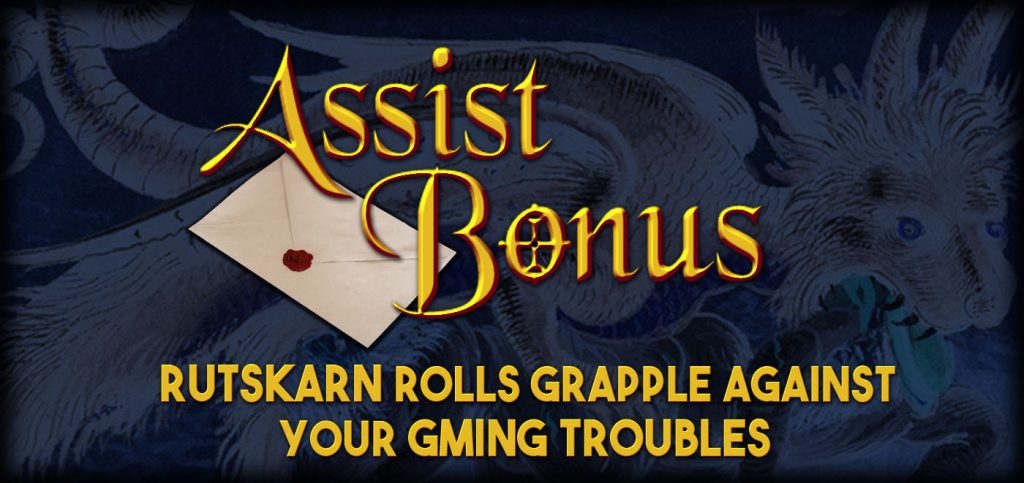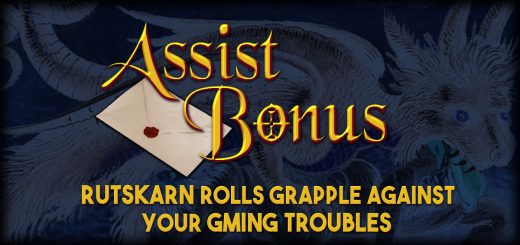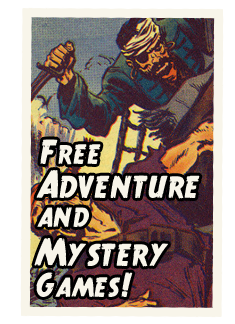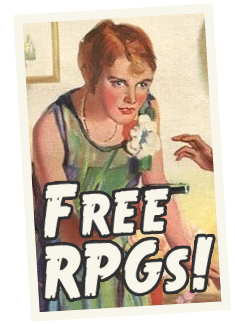Assist Bonus: How Do You Set Up Cities in Tabletop Games?

How do you set up your cities in tabletop games? Like, the actual, physical part of setting them up. Do you draw them out, use a favored tool, or do you just prefer to describe the locale and let your players imaginations do the heavy lifting? Or maybe something else?
-SwishySharp
Good question! As I’m sure you could guess, the answer varies depending on my group and the kind of game I’m running. More to the point: it varies depending on what the city is for.
An RPG map is a tool to engage with your players’ imaginations, and even a few labeled boxes on a sheet of paper collapse unknown possibilities into fewer, known possibilities. While RPG maps are neat and fun to make, I tend to do so only if there is a clearly-articulated purpose.
A good rule of thumb is that a map trades the possibility of invention for the possibilities of immersion, challenge and inspiration. When I want my world’s landscape to adapt to my group, I offer no map. When I want my group to adapt to a world’s landscape, I offer a complex map. To narrow down if I should choose one or a middle ground, I consider how play will proceed.
Let’s say I’m running a pretty casual game, one where the players take on obstacles as they come and screw around every week. In running this game, I anticipate it’ll be helpful to tailor my game to suit the whims of the group. I’ll want to adapt their gameworld to match with their current interests and attitudes, which may naturally include taking liberties with geography.
If they’re sick of trudging through Bigass Swamp, congratulations! They just reached the edge of Bigass Swamp. If they’re ready to rest up and don’t want to stress about another night’s watch schedules, congratulations! They’ve come upon the Inn of Convenience. If they’re into pirates, there’s suddenly a big pirate bay where there otherwise might have been an unmarked coastline. The only reason to have a map at all is to create a kind of menu of options for your players, but it shouldn’t be the kind of menu you get in snobby four-star restaurants where the cook gets to cattle-prod you for requesting “no mayo.”
When these players enter a city, I’m even less likely to offer a map. Why would I create an objective record of something that should, in this case, serve as a wellspring of adaptive possibilities? Going mapless means I can pull out whatever toys I need to suit the cadence of their goofy, freeflowing adventures. They ran from the guards, but oops! Now they’re in a stuffy noble district. They need a place in town that’s at least fifteen stories tall, so that’s just how high the cathedral spire is. If they suddenly have an idea they want to explore, perhaps involving a mage’s guild or noble district or sewer system, this isn’t the sort of game that benefits from the discipline of a GM saying: “Actually, there isn’t one on my map, so it doesn’t exist.” And if they want to move on to another city, I don’t have to say, “Please don’t, I’ve worked ever so hard on this map and nearly went blind shading its six thousand topiaries.”
If I were to creep away from this extreme case and towards a more disciplined game, I’d probably start picking up the mapmaking tools when I felt that a physical space was relevant to a challenge. I once ran a memorable arc pitting players against a puppetmaster in a sprawling city; as the clock ticked by in hours and minutes, he gradually brainwashed more aristocrats, subverted more guilds, deployed assassins and guardsmen, and otherwise locked down the city to trap and kill the player characters. The fun of the game would be the battle of wits between the players and antagonist. Instinctively, I knew I’d need an objective record of where places were, how long it takes to go between them, and to what extent force can be marshaled from one barracks or watch-house to another. For the players to enjoy the game, they needed the challenge to feel fair; that would mean having a sense that the districts and garrisons and noble houses in the world were objective and consistent. It meant I’d need to sketch out a placement of districts, squads, and fortifications. At the same time, I knew the challenge was going to be concentrated into a few very intense in-game days. They would never come across a legitimate city map (these are not generally common or up-to-date in a society where they must be made by hand, and they’d be enemies of the sorts of people who had them). They also would not go sightseeing, shopping, or involve most of the city’s citizens. They were unlikely to spend more than one night sleeping openly in a public building and would have little reason to enter drinking halls or social clubs, so I felt no reason to mark or characterize these.
Ultimately, I didn’t bother to create a polished version of my city map—certainly not with software or tools. I just sketched out a map during play that approximated what the players had explored and been told about. On it I noted details which were relevant to the objective challenge: garrisons and manors, fortifications, guild houses the puppetmaster would target, warehouses belonging to street gangs and criminal factions. Giving players a more complex map was not necessary because it would not inform the purpose of the map: creating a bare but informative tactical framework.
When I create a complex map, one which resolves more ambiguity about an area’s geography than it allows, it is because I am seeking two kinds of creative transaction with my players.
Firstly, I want them to understand the world as an objective and constant place which exists outside their adventures. I want to dispel their sense that I’m inventing locations and NPCs specifically to suit the PCs and their stories, grounding them in their roles as people and not protagonists. I do this mostly when I want players to have a greater appreciation for the agency of NPCs, for the arbitrary nature of the setting, for the tension of a world that might turn against them not from a GM’s malice but by sheer physics. I tend to create these kinds of maps by the traditional draw-squares-on-a-piece-of-paper method, recording numbers next to important squares that correspond to labels explaining the purpose of the building. Generally, I like to have an idea of what kinds of NPCs can be found in all of these buildings so I can create a realistic impression of depth: NPCs they encounter on the street will be able to share where they might be found again.
(Do remember that cities can be extremely large, and that by labeling all locations of interest, you risk shrinking it by dint of how much effort you’re willing to put forward. If you want to label every important place in your gangster game, my advice is to base it on Atlantic City—not Chicago. Don’t go insane trying to inject character and specificity into literally thousands of businesses.)
Alternately, I might create an objective map because I want players to create plans and solutions and stories not by inventing tools, but by creatively applying tools which already exist. If my players want a heist game that feels like a sincere test of their ingenuity, they’ll feel cheated of that challenge if I’m clearly serving up map elements (escape routes, businesses, hideouts) to suit whatever they desire. Even if they were fine with that, it can actually be harder to invent a crime given any setup than it is to imaginatively reconfigure elements which already exist. By giving players very specific street maps, I both immerse the players in their roles as meticulous burglars and provide inspiration for accomplishing their ends.
In a game like that, I may create maps digitally using software like Photoshop. My reasons for that are twofold: it allows me to design to a very fine level of detail (it’s a lot easier to pinch-zoom on a smartphone than to break out a magnifying glass) and it allows players to study the map between sessions without forcing me to run off photocopies, like a barbarian.
At present, I have not found a mapping tool or software I enjoy for almost any roleplaying application. The algorithmic ones are fun, and I’ll spend time messing around with them, but when you get right down to it the effort required to make them feel like real places is more than what’s needed to develop them from scratch. If I feel I need inspiration, I just look around for maps from whatever historical time and place is appropriate (assuming it’s either relatively modern or unusually well-preserved). For locations from less than two hundred years ago, I’ve been well-served by the keywords “fire insurance.”
As for the creative tools which offer high-quality tilesets and labeling presets, I’m not personally a fan. The slickly-polished result inevitably carries the fingerprints of the tool; even if there are icons to represent my setting’s particular sense of style, I can’t help but feel I lose some of the sense of a bespoke space I’d meant to capture in the first place. It’s kind of like using headshots of actors to represent NPCs, a practice common on Roll20 and in some live games: I definitely wouldn’t say it’s a bad thing to do, and I never turn up my nose when I’m on the player side of the table, but as a GM I’ve just never felt it was worthwhile. I’m sort of all-or-nothing with “extras” like that: either I want it to look and feel like an authentic document that’s unique to my campaign world, or I want a stripped-down cipher that lets players imagine whatever they please.
These have been my thoughts about maps. Hope that answers your question!







I’ve had a mixed method with maps myself. I usually like to have my campaigns settled on a specific place, usually a central city. So, I usually start with an outline of the city and how I want to design it, usually with a few important districts and a key point here or there for the plot but most of it blank. Then I start adding locations to the map that my players visit that are important, that way I use it more as a visual notes representation and helps keep the world consistent so that The Colorful Animal Inn doesn’t suddenly move from the docks to the Noble District which is on the opposite side of the city